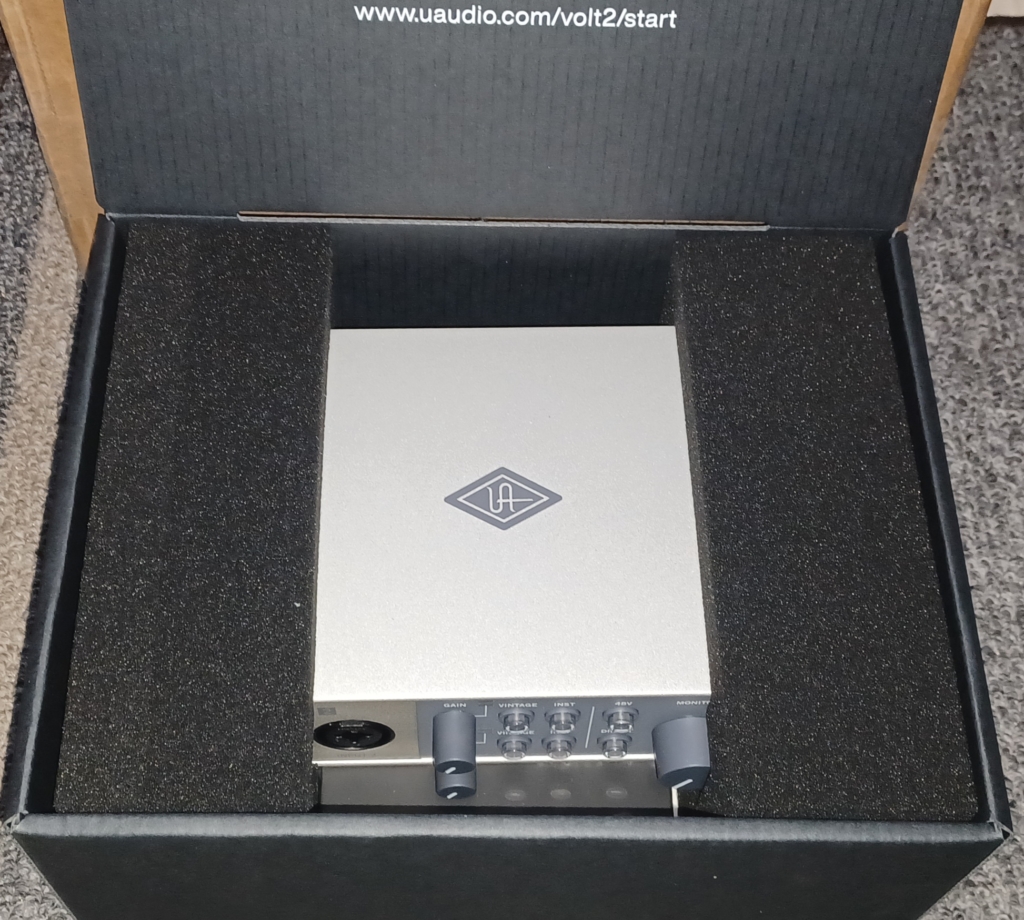Volt 2 Audio Interface Review: Where Quality Meets Consumer Friendly
Today, I’ll be reviewing an audio interface from Universal Audio, the Volt 2. In this review I will:
- Take you through its main features
- Test how it performs
- Assess build quality
- And more!
I may sound like a broken record to anyone familiar with my reviews. Nevertheless, I’ll say it once again.
Good quality audio gear has never been more affordable than it is now.
Back in the day, you used to have to spend close to a thousand dollars for an interface that was a cut above the home consumer level, which at the time wasn’t designed for professional use. This is no longer the case as companies continue to innovate while bringing costs down. Your audio interface plays just as big of a role in your sound quality/tone as your mic and physical recording space.
Disclaimer: This kit was provided free for review purposes. We also use an affiliate link in our article, which means we’d earn a small commission, should you choose to buy via it!
The Volt 2: What Is It?

The Volt 2 is a 2-in/2-out audio interface that features:
- Stereo out via ¼ inch jacks for speakers
- Shared headphone amp for channel one and two
- Direct Monitoring
- Vintage Recording Mode
- MIDI in and out x1
- 48V Phantom Power
- Instrument In
You also get a handful of free software goodies! Better yet, the price tag is only $189 USD for the Volt 2. Continue reading to find out why that is so mind-blowing!
Universal Audio has a nifty little comparison chart between the Volt 2 and Apollo Solo.

Front Perspective of the Volt 2 Audio Interface
Volt 2 Review: Recording Performance
I tested the Volt 2 with a condenser and dynamic mic, the Skylight and Limelight from 512 Audio. No extra gear is required to get healthy recording levels for a dynamic mic! The preamps need to be pushed fairly high – however, they were still clean! No hiss from the preamps was introduced to the recording from using a higher gain setting.
This raw recording (okay I took out the mouth clicks; no one wants to hear my spit) is measured at -23.84 RMS or -24LUFS with a true peak of -3.36dB… perfect!
Volt 2: Recording With Vintage Mode
I found that Vintage Mode was more beneficial for the dynamic mic test. The dynamic mic sounds slightly muddy. Vintage Mode opened up my voice, thus removing the slight mud from my voice when recording.
The opposite was true with the condenser mic test in Vintage Mode. It adds a slight touch of warmth to my voice.
Volt 2 Review: Overall Findings for Recording
What Vintage Mode does to your audio is going to be dependent on your voice, mic used, and your room (condenser mics that are more sensitive).
The Volt 2 is great for people who maybe don’t have the best-treated recording space to use a dynamic mic and its many benefits for such a scenario.
One thing that I didn’t really care for was that the Phantom Power (48V) is shared between channels 1 and 2. This means you probably shouldn’t use a condenser and a dynamic mic together. Overall, though, the preamps perform and sound great for its price tag. It really does maintain that quality expected from Universal Audio.
Recording Findings for Windows Users
Sometimes, when using an ASIO driver for your DAW, it was a common issue that audio outside of your DAW would be muted when the software was open. This isn’t the case with the Volt 2. I had audio inside Pro Tools (my DAW), and I was still able to hear audio outside of the program without any special routing.
Headphone Amp
This interface only has one headphone jack input. So if you are recording with a second person, depending on the recording setup of what you’re doing, you may need a headphone splitter. This would allow the second person to use headphones as well, but the volume will be shared. Not a big deal as this is common on units of this price range.
Related Article
Best Podcast Headphones for Recording, Editing & Production
Make recording and editing easier with a good pair of headphones for podcasting. Find out more »
The headphone amp itself, however, is quite impressive. It was able to drive my DT990 250 OHM Pros no problem. Meaning? These headphones require a lot of “power” to get them at a comfortable volume and maintain details. The headphone amp was also clean of hiss while turned up – clean headphone amp, nice! Although, for the safety of your ears, only turn up to a comfortable volume!
Monitoring Through Speakers
The Volt 2 couldn’t drive my 5.5 inch driver speakers very well. Even past the 12 o’clock position it still wasn’t the same loudness as my SSL 2+ at the 10 o’clock position. This unit operates best in a headphone environment for playback.
Recording Latency
Latency is the time it takes the audio signal to leave the interface into the DAW and be heard through your headphones. It’s usually measured in milliseconds. For the Volt 2, it’s super minimal while recording. You’ll hear slight “phasey-ness” but nowhere near an echo. The Volt 2 has direct monitoring capabilities, so this will give you zero latency while activated for recording.
The Build
The body is solid and has some weight to it. This gives it a sturdy feel. At the same time, it’s relatively compact and still light enough for mobile travel. The Volt 2 is typically USB powered. However, there is a separate DC power cable (no block included) that you can use to record directly into Apple-only mobile products, such as tablets or phones, while on the go.
The buttons are sturdy – no double pressing to activate or deactivate features. These buttons light up in bright colours too, so you know exactly if onboard features are active or not.
Volt 2 Review: Our Rating: 5/5
- Sound Quality for Price Point: 5/5
- Features and Extras for Price Point: 5/5
- Build: 5/5
- Total: 5/5
Conclusion: Volt 2 Review
All in all, the Volt 2 is a great means to tap into that Universal Audio quality without breaking the bank. Overall, it performs exceptionally well and outpaces most competition in its price range of $189.00 USD. It seems to be geared more towards solo usage in its compact design – perfect for a podcaster.
The preamps are clean and strong. Its headphone amp should be able to drive just about any headphones. The direct monitoring is nice, as well, for a podcaster, voice artist, or singer. I would definitely recommend this as a podcaster’s first interface.
If you’re still looking to shop around, though, then check out our Best Audio Interfaces for Podcasters roundup!


